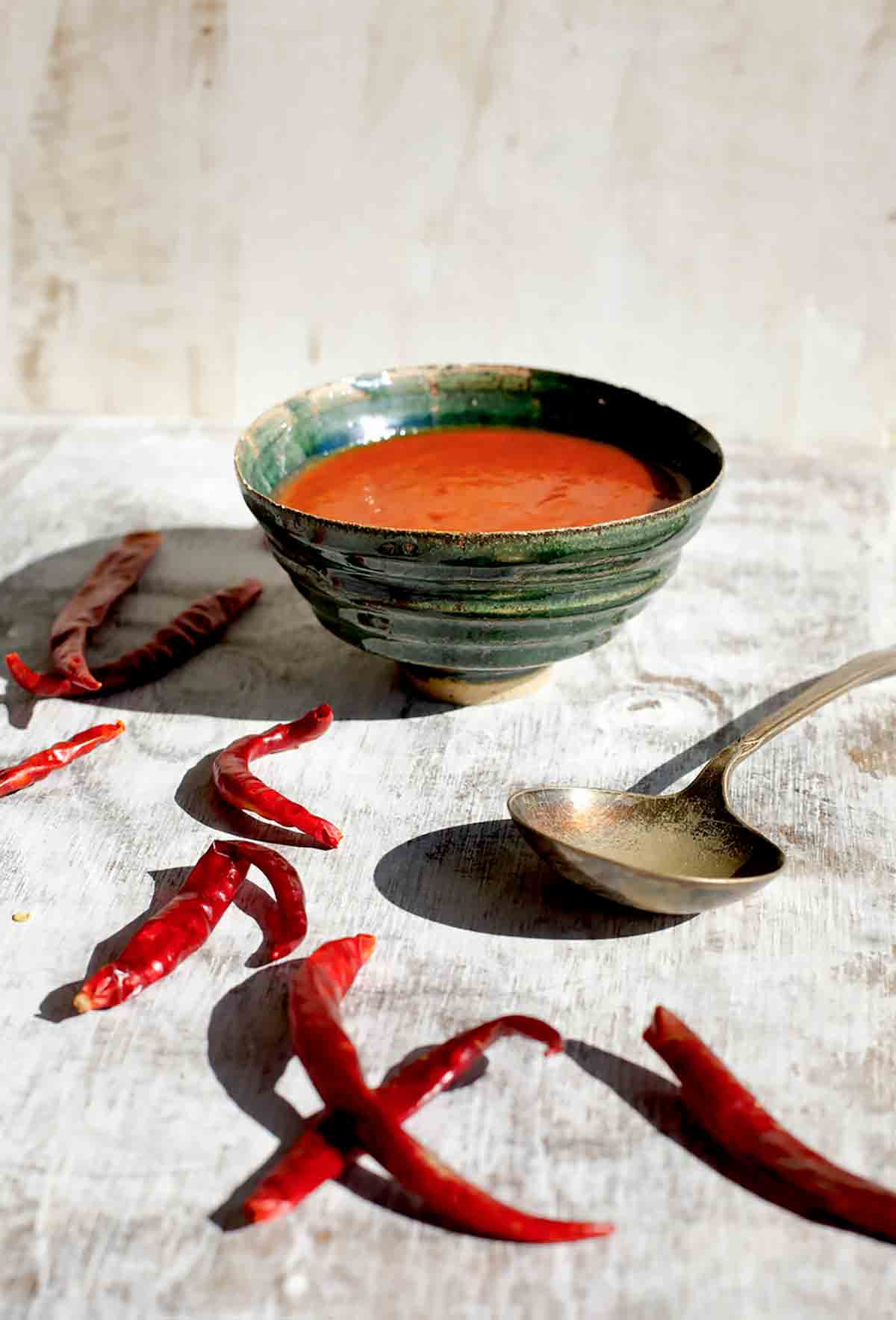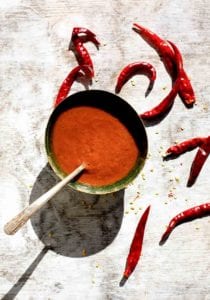
The torrid piri-piri pepper, known as peri-peri in Africa, has been a staple of the Portuguese table since the Age of Discovery beginning in the 14th century.
After Columbus brought the fiery fruit back to the continent from the New World in 1493, it was the Portuguese who carried it throughout the globe. In fact, the chili, including relatives of the African piri-piri peppers, has become so ubiquitous, it’s put to use in more than one-quarters of the world’s cuisines.
This sauce, found everywhere in Portugal and several of its former colonies, specifically Angola and Mozambique–is a must-slather on any kind of poultry, smoked spare ribs, and even grilled shrimp.–David Leite
LC Stepping In For Piri-Piri Peppers Note
Uh, the only trick is, you won’t find fresh piri-piri hot peppers stateside. Stepping in for piri-piri peppers are Thai bird (top two photos), red jalapeño, santaka, arbol, cayenne, or Tabasco, depending on availability as well as personal heat preference and tolerance. You can find dried piri-piri peppers. They pack a wallop, so experiment with the amounts so that you get the sauce you deserve.
For those concerned about the health risks of allowing raw garlic to steep in olive oil, Shirley O. Corriher, food scientist and author of Cookwise: The Hows and Whys of Successful Cooking, says that due to the sauce’s high acidity, there’s no problem. In fact, she added: “I’d be tempted to eat it myself.”


Portuguese Piri-Piri Hot Sauce
Ingredients
- 4 to 8 fresh hot chilis, depending on the heat (see LC Note above)
- 2 garlic cloves, minced
- Juice of 1 lemon
- Pinch of salt
- 1/2 to 1 cup extra-virgin olive oil, depending on how thin you want it
Instructions
- Coarsely chop the peppers and discard stems.
- Place the chilis and their seeds, the garlic, lemon juice, salt, and as much of the oil as you wish in a food processor fitted with a metal blade and purée. Pour the mixture into a small glass jar and let steep for several days in the fridge.
- You can strain the mixture and return it to jar, but I like mine with a bit of texture. Sauce will keep in the refrigerator for 1 month.

Nutrition
Nutrition information is automatically calculated, so should only be used as an approximation.
Recipe Testers’ Reviews
I received Peri Peri sauce from Africa years ago, and I rationed it like precious gold. It eventually made its way into supermarket shelves, and I was so excited to use it with abandon. I was really excited to try this recipe to see how it compares to what I’ve had in the past. I used a combination of jalapenos and habaneros, so the color was considerably more green than the picture.It had a great warmth to it on the front of the tongue and it lingered in the throat for a while. It also had a very pleasant acid level. I wanted a bit more garlic and salt, but that may come through more as it sits. I’m now just dreaming of all the meats and vegetables I’m going to drizzle this all over.I used it on cauliflower fried rice, it was fantastic.”
This spicy sauce was simple to make and can be used in a number of different ways. I used it as a marinade for a boneless turkey breast that I then baked, but it would also be great on a charred grilled chicken, or even spooned over anything needing some heat. I used 8 fresh red chilies (the variety that looks like a jalapeno but is red instead of green), 2 large garlic cloves, 2 tablespoons of fresh lemon juice, and the full 1 cup of olive oil. (Because I was wanting to have a substantial amount of sauce to marinate the entire turkey breast, I wanted a lot of sauce) I actually added in 1 1/2 teaspoons of salt here instead of a pinch Again, because this was my marinade for an entire turkey breast I didn’t want it to be lacking in flavor.
After I processed the sauce in the food processor, I let it sit in the fridge for 24 hours; I did not strain the mixture. This recipe (with the 1 cup of oil added into it) made about 2 cups of sauce. One suggestion when prepping the sauce…don’t forget to wear disposable gloves chopping the hot peppers!
Hot sauce without the vinegar with a nice after taste. For my first recipe review the simplicity worked well with only 20 minutes of hands-on time and 42 hours of steeping.I had to do some on-line research about Piri Piri sauce since my usual experience is only with Frank’s hot sauce and Buffalo Wings. I can see substituting this for Tabasco in my cooking. I will be experimenting not only with the thickened sauce but the opaque liquid that separated during refrigeration on my next batch of wings.I used 7 red Serrano peppers (102g) with 4oz of EVOO. I was able to squeeze 2Tbl of lemon juice and had 6oz of finished product before steeping. I wore gloves while prepping the peppers.
Can I start by saying “woot woot!”? January is the month I go digging into the back of my fridge and pull out a six month old packed litre jar of fermented bird’s eye chilies (my home grown piri-piri chilies) to make my fermented piri-piri sauce. Alas, there is no jar in my fridge. Last year’s crop was so meager that I just froze the chillies for individual use.
Sure, I have other recipes. I’m the girl that carries piri-piri in my purse just I case I run into food that needs rescuing.. I’m also the girl that takes an oversized lunch bag to work that accommodates various condiments including piri-piri. Never underestimate the power of a great hot sauce as a “pick me up” during a stressful day. It’s also fulfilling to be able to share one’s piri-piri with the more adventurous colleagues. Yes, I’ll share my special sauce!
When I saw this recipe, I wasn’t immediately convinced that this would be a great hot sauce. It included olive oil and only used 4 to 8 chilies. I thawed 8 of my bird’s eye chilies on paper towel so as to absorb the extra moisture. Five minutes later, I was a convert! I used my blender instead of the food processor as I have a jar just for sauces (of course I do!).
150 ml of olive oil seemed to get me the right consistency. It also emulsified the sauce so that the end result was a creamy, pleasantly hot, with a hint of lemon garlic flavour.
Straining was never a consideration. The tiny flecks of chilies just added dimension and interest to the sauce.
My first uses were little dabs in espresso spoons to confirm the sauce deserved a piri-piri title.. (wink).. I also generously doused chicken thighs in this sauce, smeared it on toasted sandwich bread, used it as a bed for smoked mackerel, and made a second batch for a couple of gifts. On day 5 of refrigeration, this piri-piri sauce remained emulsified in a soft congealed state. 5 minutes at room temperature and a quick shake of the jar brought the sauce back to free flowing and uniformly emulsified. The fact that it keeps in the refrigerator for a month means little to me as it will never last that long. Muah!













You forgot to mention paprika and one very important ingredient is a 2 tablespoons of oregano…also you can add a half red sweet peper…
Thanks, karima. It’s funny, there are as many version of this sauce as there are cooks. Glad you added your thoughts here.
Love piri-piri and always have some in hand. I always grew up with it but have a simplified yet just as good recipe which is fantastic in any type of stews. All we do is add small malagueta peppers in a tall glass container with olive oil or whiskey. Close the the container and wait until all malaguetas are at the bottom. Once that is done, you have this amazing sauce to use everything you are cooking!
Olive oil OR whiskey. Now there’s a story! Love it. Although tell me a little more, please, about malagueta peppers, please, as I’m unfamiliar with them…
The Malagueta peppers are small dried red peppers I believe originally from Moçambique. My family would always have them around and today they grow their own in their organic B&B farm. I am able to bring a few every time I go back to Portugal. Shhh… let’s not tell that to customs! It is a very powerful pepper and very tasty one too.
I’m telling customs unless you share LOL
Regarding growing of peri-peri in North America, especially northern states or Canada. No issue. Start the seeds in a tray on a bay window that receives sunshine in Feb. By April, the seedlings are ready and about 10-15cm. In May plant them outside in full sun.
Fear not, peri-peri gives real full heat no matter what; I bring in around 5 plants back inside around Oct and in the bay window. Give nice dose of sheep manure and plant feed, they love the winter by the window despite being -20C outside (inside is around 18C). They flower 2x in winter.
Some chinese stores have the dried thai chilli. It is close but not the same. I have the jwaneng, Botswana strain as well as Zimbabwean cultivar. If you are in north america, i can send you the seeds you can grow. Jwaneng is smaller pod similar to Malagueta variety but with a fiery kick. The plant lives for around 3+ yrs; I have them indoor and then outdoor in summer time. They produce prolific amounts of this beauty.
First time with Zimbabwean strain; it is 3x in size width wise but same length. This is a mighty beast which packs a much more punch than Jwaneng variety.
Sajid, now you have piqued my interest! I will have to try it for myself.
I’d love to get my hands on some seeds!
Hi, my sauce came out kinda cloudy, like the olive oil emulsified? Any idea what I did wrong?
Hi, Noel. I’m a bit stumped, yes. Not sure what would have caused that. The only thing that comes to mind is perhaps the ribs of the peppers might have clouded it? Do you have a picture?
No, I finished it anyway 🙂 would it not have something to do with the olive oil reacting with the lemon juice when being blended?
Noel, that wouldn’t be the cause–at least any more than it would be for a vinaigrette. That’s why I was asking to see a picture, if you had it. I’ll have to make it again and see if I experience it!
Sofia, my friend, the author Edite Vieira of The Taste of Portugal, does the same with whiskey. Simple and delicious.
Ha… A great book indeed. I should buy it one of these days. I have checked it at friends house. Had forgotten about it!
Dear David and Sofia and all those potential piri piri people, yes to oil AND whisky! A lovely old Portuguese couple from Mozambique had this restaurant in Johannesburg and gave us their recipe. We had big garlicky LM prawns with piri sauce dashed over them from a bottle of Johnnie Walker with holes punched in the cap. The lady added half a cup whisky to her oil/peppers/garlic/parsley/lemon juice for levels of tastes. Hotazell that came and went so enjoyably.
Peter, thank you, this is quite literally life-changing news! Seriously. That piri piri sounds amazing. It makes me think of another recipe, a boozy one similar to this, coming up shortly that you may like, I’ll note when it posts on the site…
Oh dear, Peter, I’m rather remiss in posting this update to your comment. Here’s that Sherry Pepper recipe that I’d thought of when reading about your Johnnie Walker piri sauce…
Peter, that reminds me of yet another favorite at our home growing up. My parents live in Cape Town and had a help from Mozambique who taught them one of my very favorite chutneys. Layers of lemon quarters, coarse sea salt, malaguetas, and so on until a glass jar is fully packed, then fill it with lemon juice until no air bubbles. Cover it with a cotton cloth and rope then let it slowly cook outside fully exposed to the sun and hot temperatures. Make sure to check it everyday and add lemon juice so the top does not dry up. Once it is fully cooked (about 30 days of strong sun and heat), bring it back inside, remove the cloth and close it with its normal lid. You can enjoy it simply with a nice grilled steak or go one step further and create a paste with it, butter and lots of garlic then brush your grilled chicken or ribs with it!
Would you be so kind as to write me where I might buy a bottle(s) of the peri-peri peppers (not the sauce.) Thank you for your help.
Dennis Macro
Dennis, I’ve never stumbled over the peppers in the States. I’m not sure if it’s due to any kind of an import regulation. They’re also hard to grow then in North America, because there really is no place that’s hot and dry enough to stress the plants so they turn out spicy enough fruit. What I do is bring back a bag or two of dried pepper whenever I travel to Portugal. Perhaps some of our readers can help you?
I actually found piri-piri peppers at my local Mrs. Greens in Chicago. They said they were grown in Michigan of all places. Making the piri-piri paste from The New Portuguese Table now, but ran out of whiskey so I hope brandy is good enough.
April, wow! Lucky you. I find it hard to find them. And, sure, brandy is perfectly fine. Let me know how it turns out.
Dennis,
I actually buy the dry chili peppers at Asian markets. Depending on how spicy you want to make the sauce, ask a person working at the store which to get. The latest ones I bought are called “dried japones chiles” (product of china) and have worked out pretty well. Hope this helps.
Excellent recipe! I just love this sauce and always buy Nando’s piri piri sauce, but want to start creating batches for my family as we get through so much of the stuff. I plan on making a slightly modified version of this one but apart from using the hot chillies, I will also be adding sweet red peppers and a little red wine vinegar.